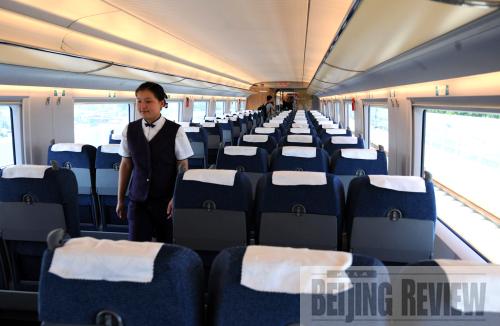|
 |
|
LIGHTNING SPEED: The Beijing-Tianjin inter-city railway adopts a number of advanced technologies to realize top speed and absolute safety |
When an array of emerging modern railways bring immediate benefits to China's mountainous and isolated regions, no one doubts that the country is moving on a fast track toward prosperity. But building railways in China can never be an easy job given its complex geological conditions and a growing need for faster and easier transportation. What it takes to tunnel through towering mountains and lay tracks in vast deserts goes far beyond the toil of construction workers. By flexing its scientific and technological muscles, China has raced ahead of most other countries in the competition of railway engineering.
Mission impossible
The Qinghai-Tibet Railway, a link to the "roof of the world," is one of the country's pioneering scientific feats that stunned the world. Running higher than any other railway in the world, it passes through remote regions of Tibet and covers more than 500 km of permafrost, which may melt when temperatures rise and destabilize the roadbeds. Intensifying global warming has even defied a batch of routine counter-measures such as raising embankments and paving the track with heat-insulating materials.
After decades of research, Chinese scientists and engineers have come up with a set of roadbed-cooling measures to prevent the permafrost from thawing. Among them, the most important is thermosyphons, steel pipes filled with an easily vaporizable liquid such as ammonia. As the liquid boils, the devices, embedded beneath the embankments, could absorb heat from the permafrost and transfer it into the air.
Another effective method to cool the permafrost is to install a block stone layer in the embankment or on a slope. In winter when surface temperature dips lower than that of the permafrost, natural air convection occurs in the block stone layer, removing heat from the permafrost. Meanwhile, a series of other cooling methods have also been adopted, including sunshine-shielding devices and crushed-rock revetments.
A number of check stations have also been set up along the railway line to monitor temperature changes in the permafrost and ensure the absolute safety of the tracks, Zhang Luxin, a permafrost expert who participated in the railway construction, said in an interview with the Beijing News.
Designers tried to make a detour around the most unstable permafrost area, or build bridges to avoid permafrost when necessary, he added.
The challenges brought by the permafrost don't end there. They also made it difficult to build tunnels such as the Fenghuoshan Tunnel, the highest of its kind in the world. Tunnel blasting produces high-temperature and high-pressure gases that may disrupt the heat balance of permafrost, causing landslides. To offset this, the engineers developed a series of advanced technologies, such as air-conditioning and installing a heat-insulation and waterproof layer on the tunnel walls. They also used brine mud to plug the blast holes to cool the explosive gases.
| 